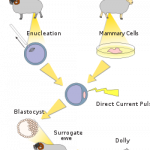cloning
I just read an article about conservationists in Brazil at the agricultural research agency (Embrapa) who are planning on cloning endangered animals using tissue samples collected from carcasses. The researchers want to clone animals that are not yet critically endangered in order to maintain them in captivity in the event that wild populations decline significantly.
Emprapa is planning to start with the maned wolf (Chrysocyon brachyurus), a species that is "near threatened" according to the IUCN Red List of endangered species. Other planned species include jaguars, black lion…
It turns out that my wonderful iGEM students, besides being brilliant scientists, are also excellent, hilarious actors. Please enjoy their Jersey Shore inspired video about molecular cloning:
New in vitro fertilization technology is making it possible for someone to have two moms--one that provides the genome in the nucleus of the cell, and one that provides the rest of the egg cell, including the mitochondria. Since all mitochondria are passed down from the mother in the egg (sperm are just too small to provide anything but the father's genetic material to the fertilized embryo), transplanting the nucleus from a fertilized embryo to an egg from a different woman can bypass the transmission of any mitochondrial diseases that the mother carries. Because mitochondria have their own…
There's been lots and lots written about the ethics of commercially cloning dogs and other pets -- a practice I see as a prime example of extreme human idiocy. Who spends gazillions of dollars cloning a pet dog when it's widely known that (a) the resulting puppies won't be copies of the origianl dog, (b) they'll likely have health problems, and (c) there are SO MANY PUPPIES that need homes? The answer: Very disturbing people, that's who. (And it doesn't look like this problem is going away any time soon.) I say all of this to raise yet another issue I have with the…
Cloning the gene for green fluorescent protein is fun. Lots of fun. Cloners have put the GFP gene into rabbits, plants, cats, fish, and worms, and made mutants that code for proteins in every color of the fluorescent rainbow. Teachers like GFP so much that every year, high school students throughout the U.S. clone GFP in biology class.
Now, some people, who call themselves DIY biologists, have started cloning GFP for fun in their kitchens. Other people find this alarming.
From Yahoo news:
Jim Thomas of ETC Group, a biotechnology watchdog organization, warned that synthetic organisms…
Over at What's New in Life Science Research, I have some thoughts about the misperceptions surrounding cloning. Head on over, and keep Our Benevolent Seed Overlords happy.
What kind of dead animals are in your freezer? I used to be skeptical about the whole notion of cloning wooly mammoths. But this recent article in PNAS (1), makes the whole idea seem less far fetched.
Wakayamaa et. al. describe an amazing technical advance where scientists in Japan were able to derive clones from mice that had been frozen for 16 years at -20°C.
I'm guessing that this wasn't one of the freezers with an automatic defrost cycle.
Sure, this demonstration is still a long way from cloning an elephant or related species. Even cat and dog cloning are fairly recent advances…
I've heard that all cats are grey in the dark, but I guess that's no longer true in New Orleans. Scientists at the Audubon Center for Research of Endangered Species have made a cloned kitty that glows lime green.
Some of you already know my fascination with glowing fish, fluorescent cats, and cloned puppies. This New Orleans cat is interesting too, partly, because it's the first transgenic cat made in this country, and partly because of the work that ACRES has been doing to try and rescue endangered species.
ACRES has made the headlines before. Dr. C. Earle Pope and Dr. Martha Gomez,…
Leave it to those wacky Korean cloners. In December, scientists from Gyeongsang National University gave us fluorescent kitties. Now, we have cute little puppies!
These aren't the first cloned pets on the market, we have stores that sell glowing fish. But these clones have a bit higher price tag. For $50,000 Bernann McKinney got 5 new "Boogers" from RNL Bio; "Booger McKinney," "Booger Lee," "Booger Ra," "Booger Hong and "Booger Park." That's $10,000 a Booger!
Still, who can resist these cute little boogers? I have a picture of the puppies below the fold and as you can see, they're…
Pet cloning is back!
Pets are funny things. Some owners find their pets to be closer than some human friends, other owners never really bond with their pets at all.
BioArts, a California biotech company, founded by ex-CEO of the now defunct Genetic Savings & Clone, is counting on the strength of those human-dog emotional bonds .
I've had several pets during the course of my life; dogs, cats, fish, scorpions, spiders, frogs, turtles, gerbils, and a hermit crab. Some pets were really easy to train and live with and some - well, let's just say some were more challenging. So, I…
Many animals have cunning ways of hiding from predators. But the larva of the sand dollar takes that to an extreme - it avoids being spotted by splitting itself into two identical clones.
Sand dollars are members of a group of animals called echinoderms, that include sea urchins and starfish. An adult sand dollar (Dendraster excentricus) is a flat, round disc that lives a sedate life on the sea floor. Its larva, also known as a pluteus, is very different, a small, six-armed creature that floats freely among the ocean's plankton.
A pluteus can't swim quickly, so there is no escape for one…
What? Is this a joke, Ethan? Have you been watching Jurassic Park again, drinking Dino DNA or something? No, I got an interesting question from startswithabang.com reader and ichthyophobe Lucas:
Over the years a few intact, frozen woolly mammoth have been found and procured by different scientists and governments, most recently Japan. What are they doing with these ancient popsicles? Cloning? Could a frozen woolly mammoth be effectively cloned?
Aaah, the woolly mammoth, something we think of as ancient, but really it only went extinct an estimated 3,700 years ago, with the last mammoths dying…
Finally:
A long-awaited final report from the Food and Drug Administration concludes that foods from healthy cloned animals and their offspring are as safe as those from ordinary animals, effectively removing the last U.S. regulatory barrier to the marketing of meat and milk from cloned cattle, pigs and goats.
The 968-page "final risk assessment," not yet released but obtained by The Washington Post, finds no evidence to support opponents' concerns that food from clones may harbor hidden risks.
But, recognizing that a majority of consumers are wary of food from clones -- and that cloning…
This is a-mewsing.
(Photo Credit: Gyeongsang National University)
When Genetic Savings and Clone shut their doors it looked like wishful cat owners were going to be out of luck and short of kittens.
Never fear, the South Korean scientists at Gyeongsang National University have come to the rescue. I couldn't find all the details in the news articles but it appears that they inserted a gene for red fluorescent protein into a somatic cell from a cat, transplanted the cell into an egg cell, put the egg into a female cat's womb and a few weeks later, voila!, lovely white Angora cats that…
tags: book review, biotechnology, biomedicine, stem cells, ethics, Cloning: A Beginner's Guide, Aaron Levine
Would you drink milk from a cloned cow?
Should we clone extinct or endangered species?
Are we justified in using stem cells to develop cures?
When will we clone the first human?
Ever since Dolly the sheep was born, questions like these have been part of the public consciousness, and now, cloning is poised to revolutionize medicine, healthcare, and even the food we eat. Regardless of what certain politicians do to slow the progress of scientific research, cloning is here to stay, and…
The U.S. Office of Research Integrity announced this week that it has found a former postdoc in Gerald Schatten's lab, Park Jong Hyuk, guilty of research misconduct for falsifying images in a manuscript on deriving embryonic stem cells from cloned rhesus monkeys. Although the paper had not yet been submitted for peer review, this is more bad news for Schatten, who has been dealing with the fallout from being a senior author on one of the papers later determined to have been fabricated by discredited South Korean researcher Hwang Woo Suk.
The AP reports:
The latest university probe showed…
The FDA -- after years of twiddling their thumbs because of the irrational fears of "consumer" groups -- has finally approved cloned food for human consumption:
After years of delay, the Food and Drug Administration tentatively concluded yesterday that milk and meat from some cloned farm animals are safe to eat. That finding could make the United States the first country to allow products from cloned livestock to be sold in grocery stores.
Even if the agency's assessment is formally approved next year, consumers will not see many steaks or pork chops from cloned animals because the technology…
New Scientist is reporting on a movement among some scientists to replace the word "cloning" with "somatic cell nuclear transfer":
Don't say cloning, say somatic cell nuclear transfer. That at least is the view of biologists who want the term to be used instead of "therapeutic cloning" to describe the technique that produces cloned embryos from which stem cells can then be isolated. This, they argue, will help to distinguish it from attempts to clone a human being.
But will it? Kathy Hudson and her colleagues at the Genetics and Public Policy Center in Washington DC asked more than 2000…
This week's Ask a ScienceBlogger question is:
On July 5, 1996, Dolly the sheep became the first successfully cloned mammal. Ten years on, has cloning developed the way you expected it to?
In short, my answer is yes. Although the number of species of mammals cloned has increased, slowly but surely, nobody is cloning their dead relatives yet. No surprise there. In 2006, though, cloning for cloning's sake isn't where it's at. Instead, the future of cloning lies in its applications to biomedical research. Today, that means, among other things, the prospect of using cloning to generate…


